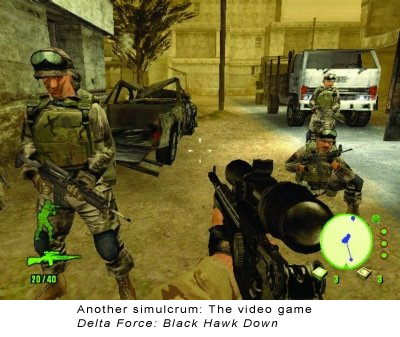
Office: HGH 210; phone: (408) 924-5378
Email: wooda@email.sjsu.edu
Web: http://www.sjsu.edu/faculty/wooda
 |
Dr. Andrew Wood Office: HGH 210; phone: (408) 924-5378 Email: wooda@email.sjsu.edu Web: http://www.sjsu.edu/faculty/wooda |
Klien, S. A. (2005). Public character and the simulacrum: The construction of the soldier patriot and citizen agency in Black Hawk Down. Critical Studies in Media Communication, 22(5), 427-449.
Note: These comments are not designed to "summarize" the reading. Rather, they are available to highlight key ideas that will emerge in our classroom discussion. As always, it's best to read the original text to gain full value from the course.
 Stephen
Klien reads Black Hawk Down (BHD) as an extension of a trend in contemporary
war films that he claims began with Saving Private Ryan: a reconstruction
of the legitimacy of U.S. military action that avoids traditional patriotic
devices. By means of introduction, Klien begins his essay by noting the rise
of televisual norms that privilege iconic visual images over complicated realities:
“There is no Defense Department apparatus, there is Donald Rumsfeld”
(p. 428). From this, Klien previews his focus on the means through which media
employ loud explosions and spurting blood to anesthetize viewers from complex
realities. Klien’s thesis: “the film seems to invite a paradoxical
consequence: The American viewing audience may conflate personal support of
American soldiers with support of American military policy, in spite of evidence
that the policy itself is misdirected or ineffectively executed” (p. 428).
From this point, Klien offers a review of literature related to war films (inexplicably
choosing not to cite Ehrenhaus and Owen).
This literature review leads Klien to suggest that the current trend in war
films is the “pro-soldier, anti-war" movie: neo-patriotism.
Stephen
Klien reads Black Hawk Down (BHD) as an extension of a trend in contemporary
war films that he claims began with Saving Private Ryan: a reconstruction
of the legitimacy of U.S. military action that avoids traditional patriotic
devices. By means of introduction, Klien begins his essay by noting the rise
of televisual norms that privilege iconic visual images over complicated realities:
“There is no Defense Department apparatus, there is Donald Rumsfeld”
(p. 428). From this, Klien previews his focus on the means through which media
employ loud explosions and spurting blood to anesthetize viewers from complex
realities. Klien’s thesis: “the film seems to invite a paradoxical
consequence: The American viewing audience may conflate personal support of
American soldiers with support of American military policy, in spite of evidence
that the policy itself is misdirected or ineffectively executed” (p. 428).
From this point, Klien offers a review of literature related to war films (inexplicably
choosing not to cite Ehrenhaus and Owen).
This literature review leads Klien to suggest that the current trend in war
films is the “pro-soldier, anti-war" movie: neo-patriotism.
This neo-patriotism may be found in four components. The first is BHD’s
critique of military policy in Somalia. The second is the moral tension between
the U.S. and Somali warlords. The third is the transformation of military motives,
from idealism to survival. These first three components are clear enough. But
we should focus a bit on the fourth: The hyperreal spectacle of battle. Klien
reads this latter component as a means to obscure complex policy debates and
place the viewer in an overwhelming sensory experience that reduces the possibility
for meaningful critique. To this analysis, Klien employs Jean Baudrillard’s
[learn more] notion
of simulacra: “the replacement of reality with a montage
of signs designed to resemble reality” (p. 437). The resulting sense of
cinematic reality provides viewers an experience of war without messy debates
of policy. Thus, while written accounts of the 1993 Battle of Mogadishu suggest
that American soldiers abandoned the rules of engagement and intentionally shot
Somali civilians, the film edits such ambivalent narratives from the screen.
For Klien, this is hyperreality, making war “even better
than the real thing."
From this critique, Klien turns to a discussion of the “public character”
of BHD. Based on the preceding analysis, Klien argues that the film, “reveals
an ideological worldview that simplifies public evaluation of military action,
eschewing the moral and pragmatic complexities of military policy and embracing
the simple ethic of the humbly heroic solider” (p. 441). This critique
motivates the author’s shift from a discussion of the film to a reading
of America’s presence in Iraq as a manifestation of such thinking.
[Return to Syllabus]